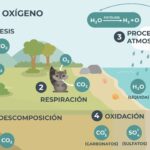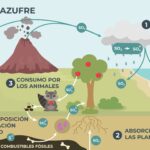We explain what biogeochemical cycles are and what they are, and what each one consists of. In addition, you will know the types of cycles that exist and their importance.
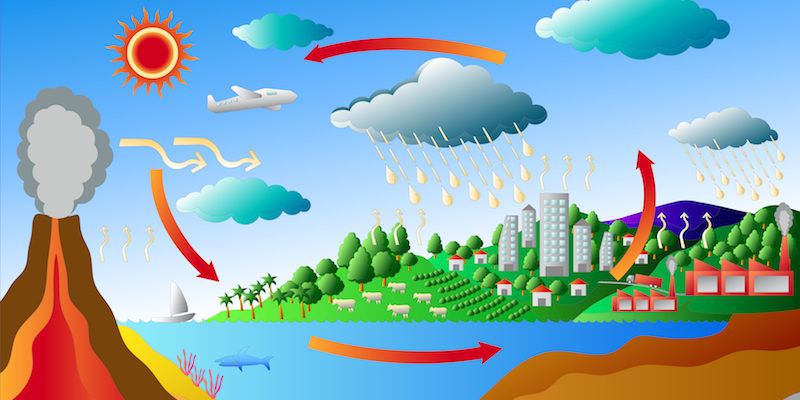
What are biogeochemical cycles?
Biogeochemical cycles are the circulation of chemical elements between living beings and the environment that surrounds them through processes such as transportation, production and decomposition.
The main biogeochemical cycles are:
- water cycle
- oxygen cycle
- carbon cycle
- Nitrogen cycle
- Phosphorus cycle
- Sulfur cycle
- Potassium cycle
- calcium cycle
Biogeochemical cycles involve living organisms, such as animals or plants (called biotic factors), and physical and chemical components, such as air, water or soil elements, that do not have life (abiotic factors). These factors interact with each other to maintain the balance of ecosystems.
Thanks to biogeochemical cycles, many elements and chemical compounds can be part of a living organism at a certain time and then become part of the surrounding environment. For example, a water molecule can be part of a human being's body now and in a few hours it can be eliminated through urine and become part of a lake.
Types of biogeochemical cycles
Biogeochemical cycles can be classified according to different criteria.
Depending on the means of transport used to transport the chemical elements, biogeochemical cycles can be:
- Gaseous They are those cycles in which the atmosphere intervenes in the circulation of chemical elements. For example: the cycle of oxygen, nitrogen and carbon.
- Sedimentary They are those cycles in which sedimentation constitutes the means of transport of chemical elements, that is, nutrients and chemical elements accumulate and exchange in the Earth's crust. For example: the phosphorus cycle.
- Hydrological They are those cycles in which water intervenes as a means of transport for the different chemical elements. For example: the water cycle.
Depending on the extent of the region where the chemical elements move, the cycles can be:
- Local cycles They are cycles that are not very mobile and occur in a small or local region. These cycles develop mainly in the soil. For example: the phosphorus and calcium cycle.
- Global cycles. They are cycles that occur in broad regions, which are global. The atmosphere intervenes in these cycles. For example: the oxygen cycle.
water cycle
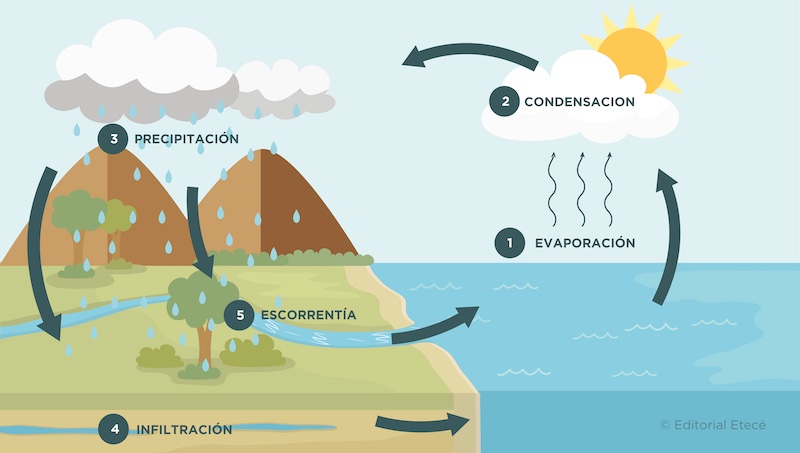
The water cycle or hydrological cycle is the process of water circulation on planet Earth. This cycle is essential for the transport of nutrients and to ensure the necessary levels of humidity to sustain life in ecosystems.
The water cycle is made up of different stages:
- Evaporation Water goes from a liquid to a gaseous state due to the increase in temperature, and the water vapor rises to the atmosphere, where it is condensed. It occurs when the sun heats the surface of rivers, lakes, seas and oceans, when plants transpire and when animals sweat.
- Condensation Water in the gaseous state turns into a liquid state when the temperature decreases, and clouds and fog are formed.
- Precipitation The water droplets condensed in the clouds acquire such weight and size that they begin to descend towards the Earth's surface in the form of rain or precipitation.
- Infiltration. Water that falls to the ground through precipitation penetrates the earth's surface and circulates as groundwater.
- Runoff Water that is not infiltrated moves over the earth's surface through the different water flows.
Freezing and melting: In areas that reach temperatures below 0ºC, water freezes (changes from a liquid state to a solid state), and can form glaciers or fall as snow or hail. When the ice melts due to the increase in temperature, the melting process occurs and it becomes a liquid state.
oxygen cycle
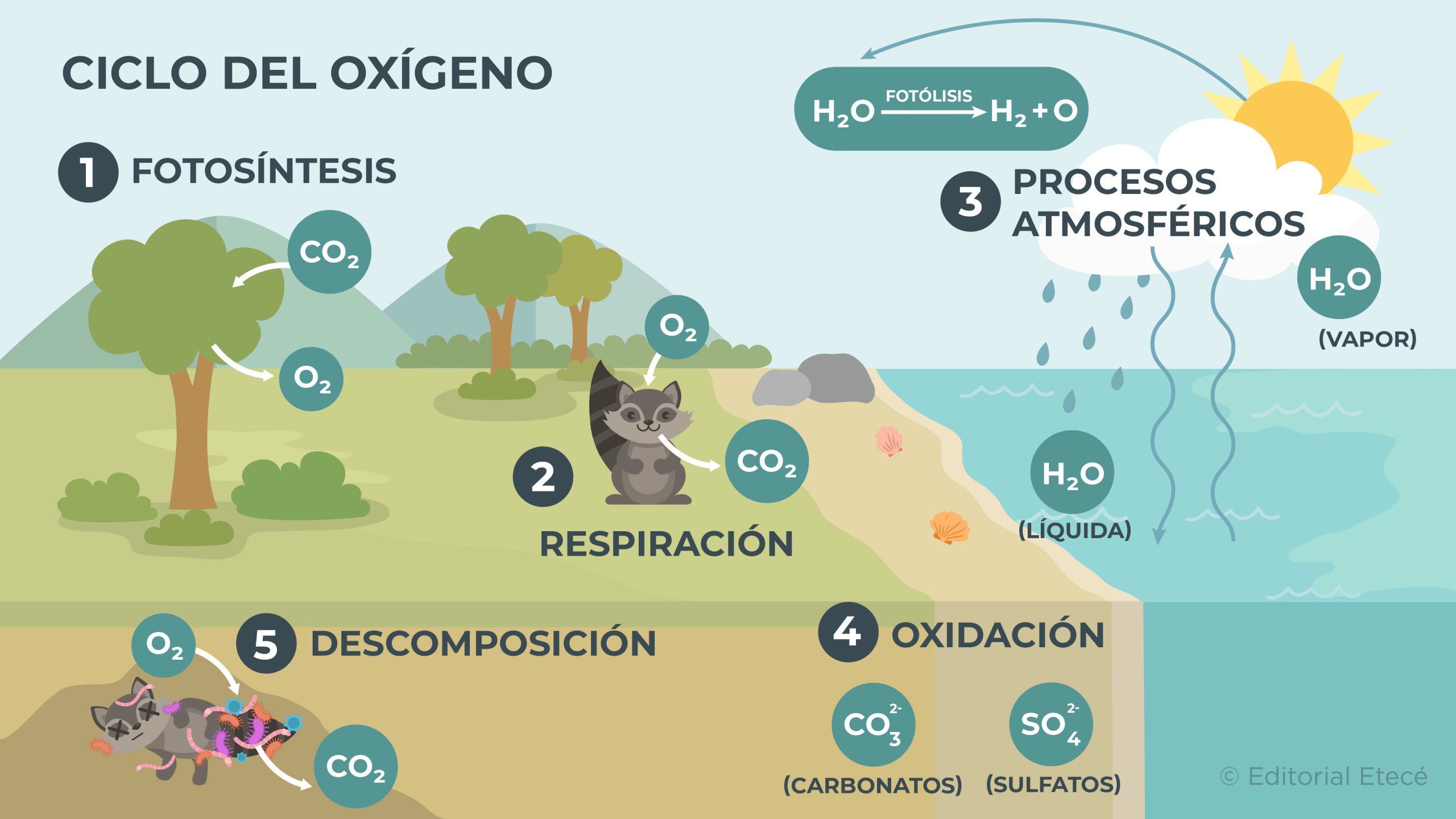
The oxygen cycle is the process of oxygen circulation on the planet. This cycle ensures that living beings can use oxygen to obtain energy and carry out their vital functions.
The oxygen cycle is made up of several stages:
Rapid or biological stage
The biological stage of the oxygen cycle is the part of the biological processes of living beings. It includes the following processes:
- Photosynthesis. Plants, algae, and phytoplankton carry out photosynthesis, which is a process by which they use carbon dioxide, water, and sunlight to obtain energy and synthesize their nutrients. In this process these organisms release oxygen into the atmosphere.
- Breathing. Animals use the oxygen released into the atmosphere to carry out respiration, and in this process they release carbon dioxide and water vapor into the atmosphere, which are compounds that also contain oxygen. On the other hand, during the night plants also use oxygen and release carbon dioxide.
Slow or geological stage
The geological stage of the oxygen cycle goes through the processes of oxidation of chemical elements and the decomposition of chemical compounds. In this stage the following processes occur:
- Part of the hydrological cycle and atmospheric processes. During the hydrological cycle, the evaporation of water present on the earth's surface occurs. Water molecules in the atmosphere are separated into hydrogen and oxygen by solar radiation.
- Oxidation. Oxygen found in the atmosphere, hydrosphere, and lithosphere can combine with minerals and chemical elements and compounds to form oxidized compounds that decompose and release oxygen.
- Decomposition. When an organism dies, it decomposes due to the action of certain microorganisms that use oxygen to carry out their decomposition and, in turn, release carbon dioxide.
See also: Oxygen cycle
carbon cycle
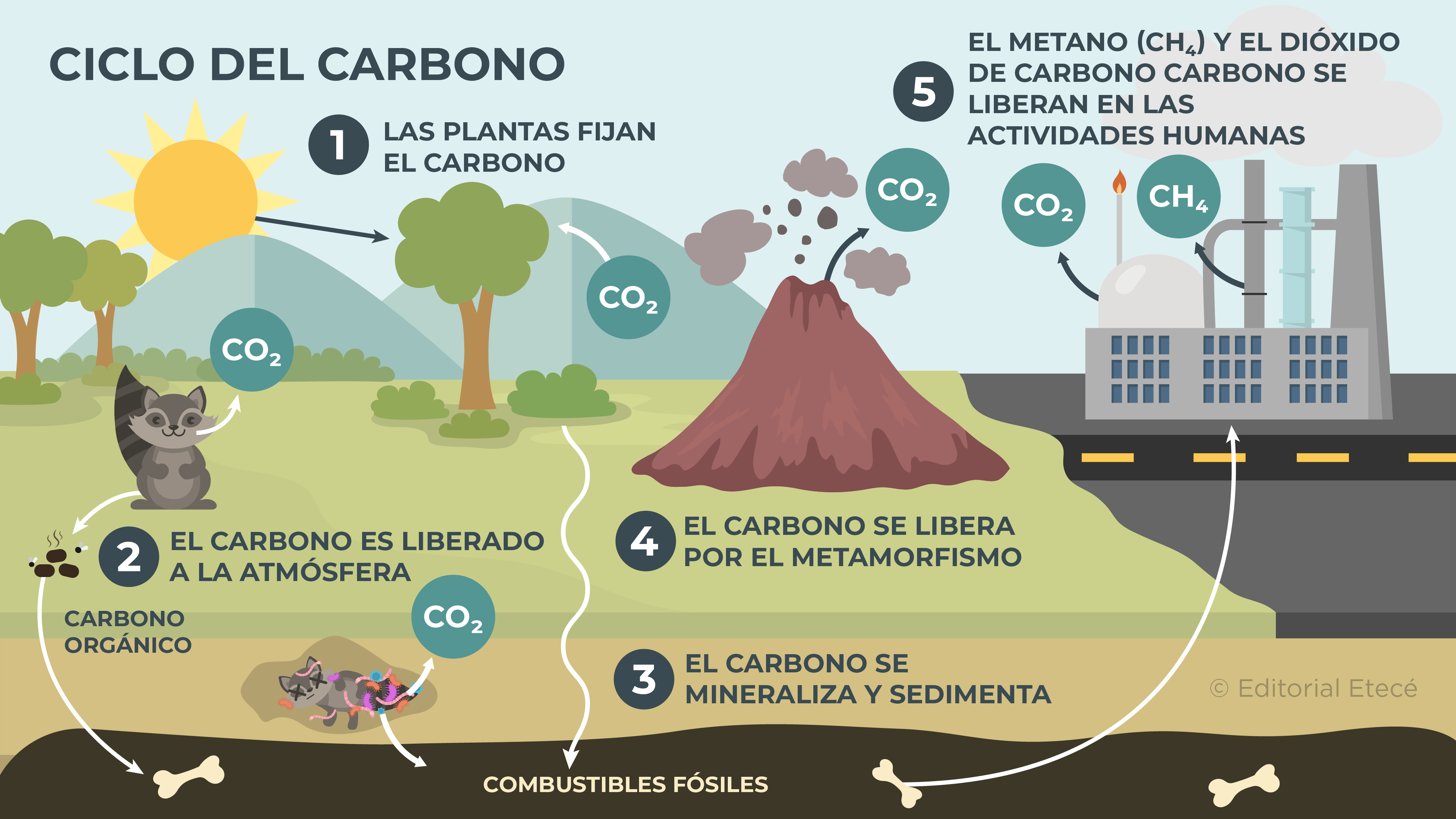
The carbon cycle is the process of carbon circulation on planet Earth. Despite being a global cycle, carbon combines differently with other chemical elements depending on the regions in which it is found. It is a very important cycle because carbon is part of the essential molecules that make up living beings, such as proteins, DNA, RNA, carbohydrates and lipids.
The carbon cycle is made up of several stages.
Rapid or biological stage
The biological stage is that which occurs in the biological processes of living organisms. It contains the following processes:
- Carbon fixation by plants. Plants and some bacteria fix carbon when they capture carbon dioxide (CO2) from the atmosphere while they carry out photosynthesis.
- Release of carbon into the atmosphere. The CO2 It is released into the atmosphere as a result of cellular respiration in living organisms, the respiration of plants at night, and the decomposition of organic matter that occurs after the death of living beings.
Slow or geological stage
The geological stage is that constituted by chemical and physical processes, and the exchange of carbon in the different earth layers. It contains the following processes:
- Carbon mineralization and sedimentation. Carbon sediments and forms fossils and fossil fuels.
- Carbon release due to metamorphism. The carbon present in carbonate rocks is released when these rocks move. Additionally, carbon is released as a result of volcanoes erupting.
- CO release2 and methane (CH4) in human activities. In many industrial processes, in mining and in the exploitation of fossil fuels, large amounts of carbon are emitted into the atmosphere as part of the release of CO2 and C.H.4.
See also: Carbon cycle
Nitrogen cycle
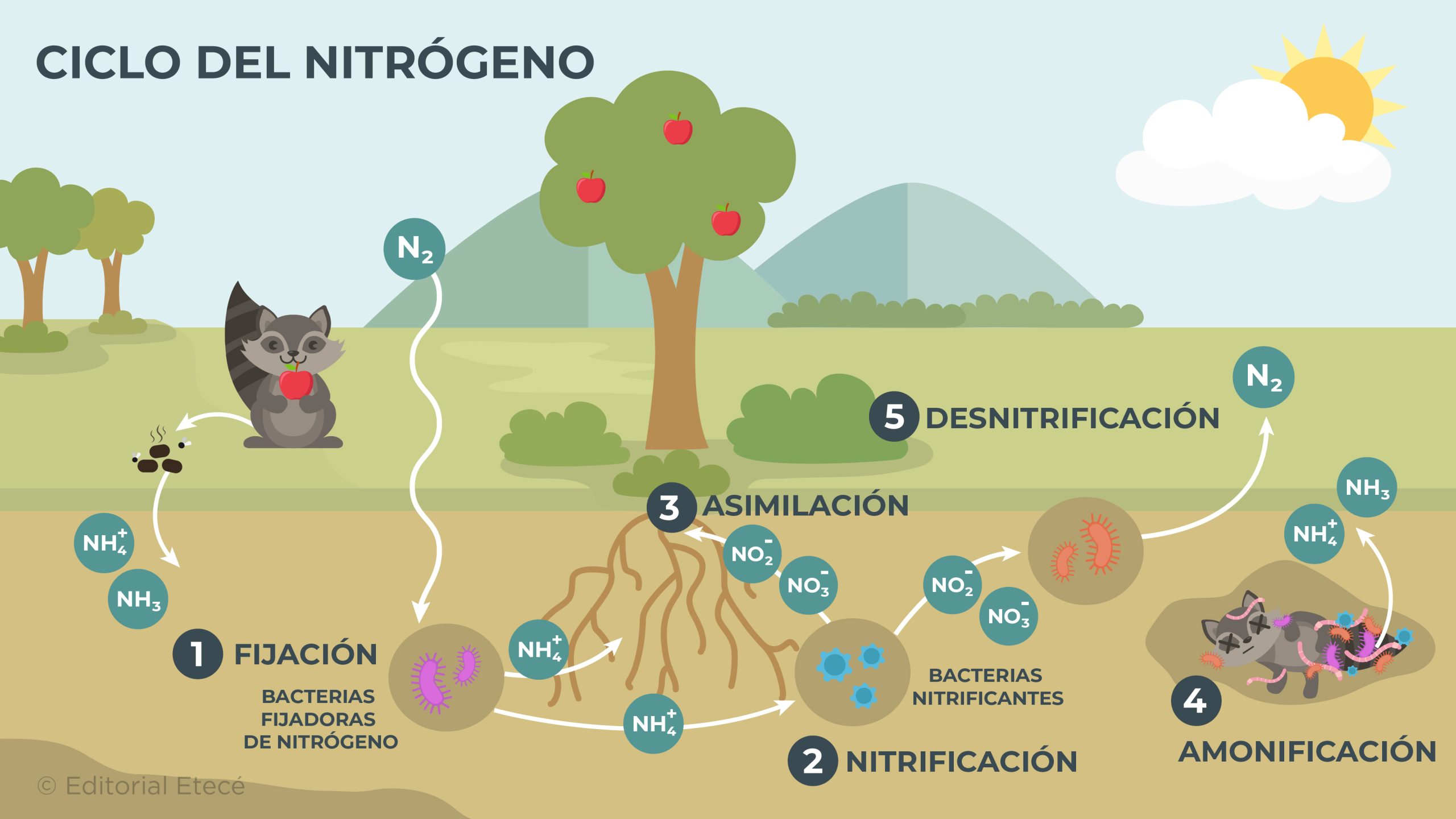
The nitrogen cycle is the process of nitrogen circulation on planet Earth. This cycle is fundamental for soil fertility and the formation of many biomolecules that are essential to sustain the life of living beings.
The nitrogen cycle is made up of several stages:
- Fixation It is the process by which living organisms use nitrogen in their metabolism. In this process, atmospheric nitrogen (N2) combines with hydrogen or oxygen to be used by living beings. Fixation can occur by microorganisms or by oxidation of atmospheric nitrogen.
- Nitrification It is the process by which ammonia (NH3) or the ammonium ion (NH4+) are transformed into nitrite ions (NO2–) or nitrates (NOT3–), which are the chemical forms of nitrogen that plants and animals can assimilate. This process occurs due to the action of certain microorganisms.
- Assimilation It is the process by which plants and animals incorporate nitrogen into their organisms. Then, when they die, they decompose and the nitrogen returns to the medium.
- Ammonification It is the process by which the nitrogen contained in living beings in their bodies is released in the form of ammonia (NH3) or ammonium ion (NH4+). This occurs when living things die or release waste such as urine and excrement.
- Denitrification It is the process by which some organisms (denitrifying bacteria) decompose nitrate and nitrite ions, releasing gaseous nitrogen into the environment. The gaseous nitrogen incorporated into the soil and water is then released into the atmosphere.
See also: Nitrogen cycle
Phosphorus cycle

The phosphorus cycle is the process of circulation of phosphorus on planet Earth. Phosphorus is the scarcest nutrient, and is part of many biomolecules essential to sustaining life, such as phospholipids, which are found in cell membranes.
The phosphorus cycle is made up of several stages:
- Weathering. Rocks and minerals located in the Earth's crust decompose due to the action of wind, rain, temperature and other erosive agents. For rocks and minerals containing phosphorus, weathering causes the release of phosphates (PO43-) towards the ground.
- Absorption by plants Through their roots, plants incorporate the phosphorus present in the soil, which is in the form of phosphates.
- Assimilation by animals Animals incorporate phosphorus when they consume plants or other animals that contain phosphate ions.
- Decomposition and mineralization Plants and animals die and other organisms decompose their remains. During this process, phosphorus, which is part of the organic molecules that make up plants and animals, is released into the soil and water in the form of inorganic phosphates.
- Sedimentation and rock formation Over time, inorganic phosphates settle to the bottom of lakes, rivers and seas, where they accumulate and are compressed to form phosphate rocks.
- Subduction. When a tectonic plate sinks into the Earth's interior, phosphorus present on a sunken plate can return to the surface during volcanic activity.
See also: Phosphorus cycle
Sulfur cycle
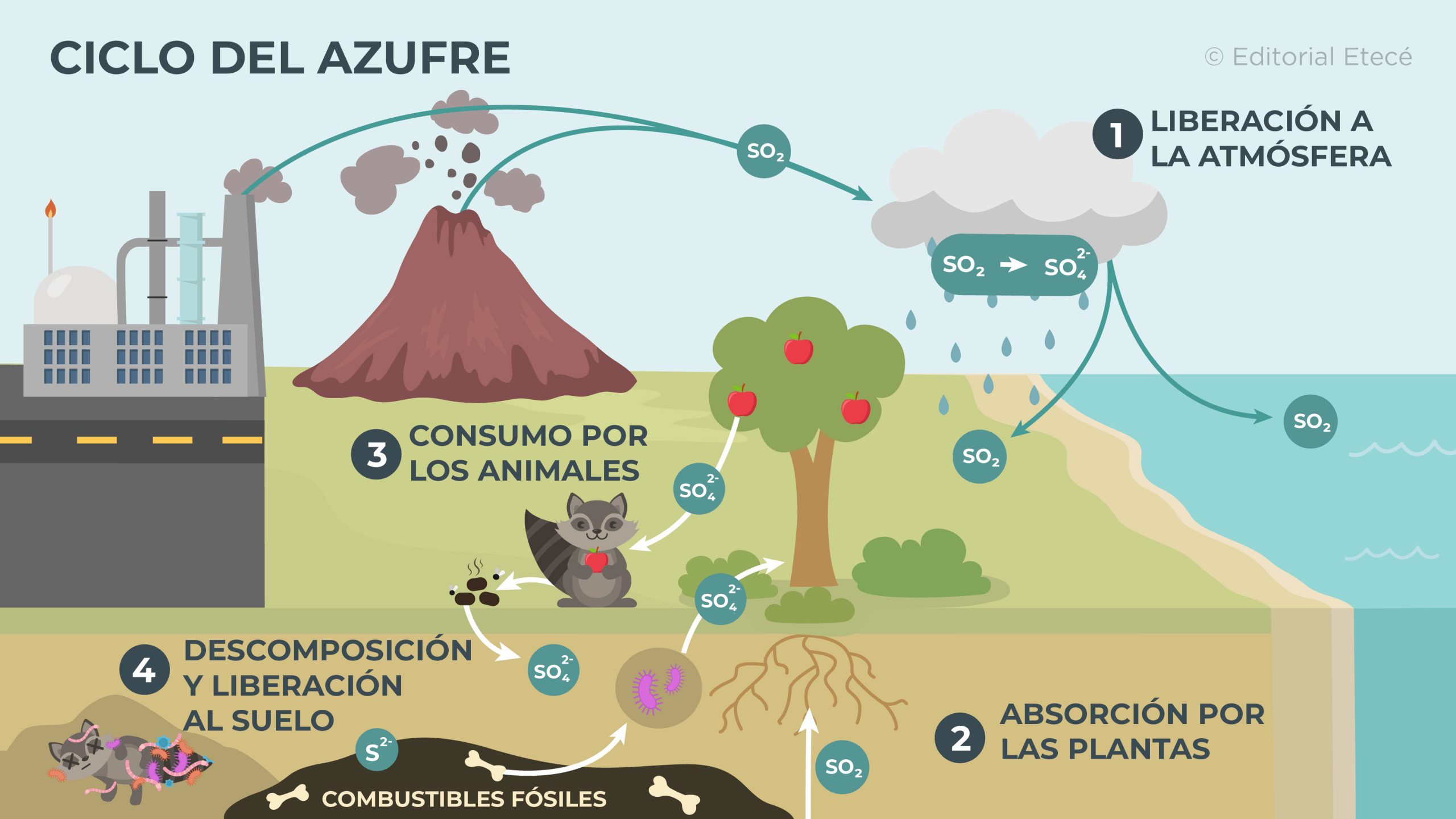
The sulfur cycle is the process of sulfur circulation on planet Earth. Sulfur is an element that is part of some proteins and its deficiency in humans causes the degeneration of cartilage and tendons.
The sulfur cycle is made up of several stages.
- Release to the atmosphere. Sulfur is released into the atmosphere in the form of sulfur dioxide (SO2), which is emitted in the eruption of volcanoes and in the industrial activity produced by human beings.
- Absorption by plants Sulfur is found in soil or water in the form of sulfate ions (SO42-). Plants incorporate it through their roots and use it to carry out their vital functions.
- Consumption by animals Sulfur is incorporated into herbivorous animals when they eat plants that contain it, and into carnivorous animals when they feed on herbivores.
- Decomposition and release to the soil When plants and animals die, other organisms (bacteria and fungi) decompose their remains and transform the sulfides into sulfates again. Thus, these sulfates are absorbed again by the plants.
Potassium cycle
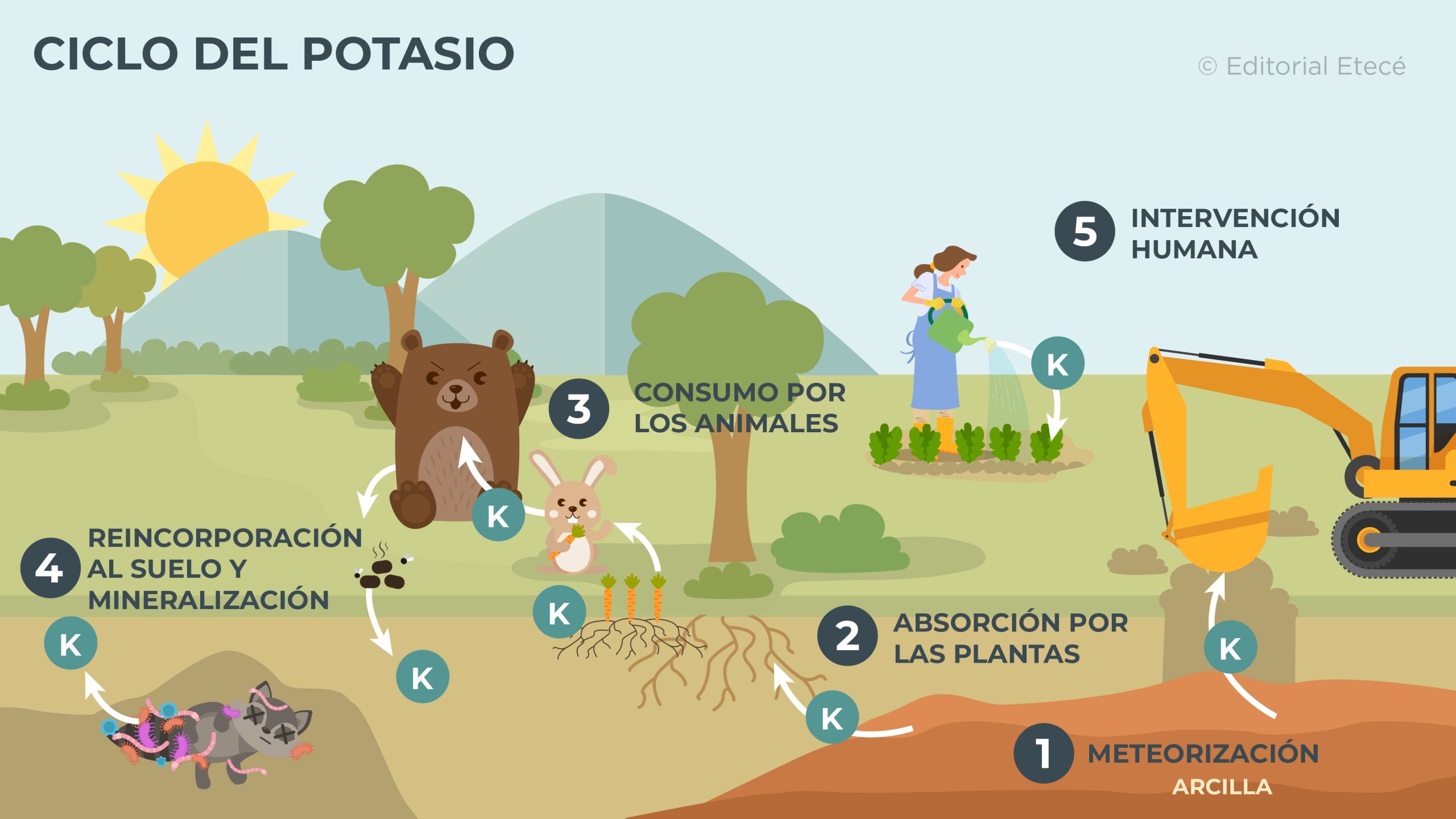
The potassium cycle is the process of potassium circulation on planet Earth. It is a fundamental cycle, since Potassium actively participates in the metabolism of living beings.
The potassium cycle is made up of several stages:
- Weathering Potassium is found mainly in the sheets that form clays and in the structure of some rocks. When rock weathering occurs, potassium is released and can be absorbed by plants.
- Absorption by plants Plants absorb potassium ions (K) through their roots.+) dissolved in soil water.
- Consumption by animals Herbivorous animals incorporate potassium because they consume plants. On the other hand, carnivorous animals feed on herbivorous animals and thus incorporate potassium into their bodies.
- Reintegration into the soil and mineralization Potassium is returned to the soil when plants and animals die, which decompose, releasing potassium. Potassium is also released into the soil through animal feces and urine.
- Human intervention Human beings have modified the natural potassium cycle. This has happened due to the mining of potassium-rich rocks and the addition of potassium-containing fertilizers to the soil.
calcium cycle
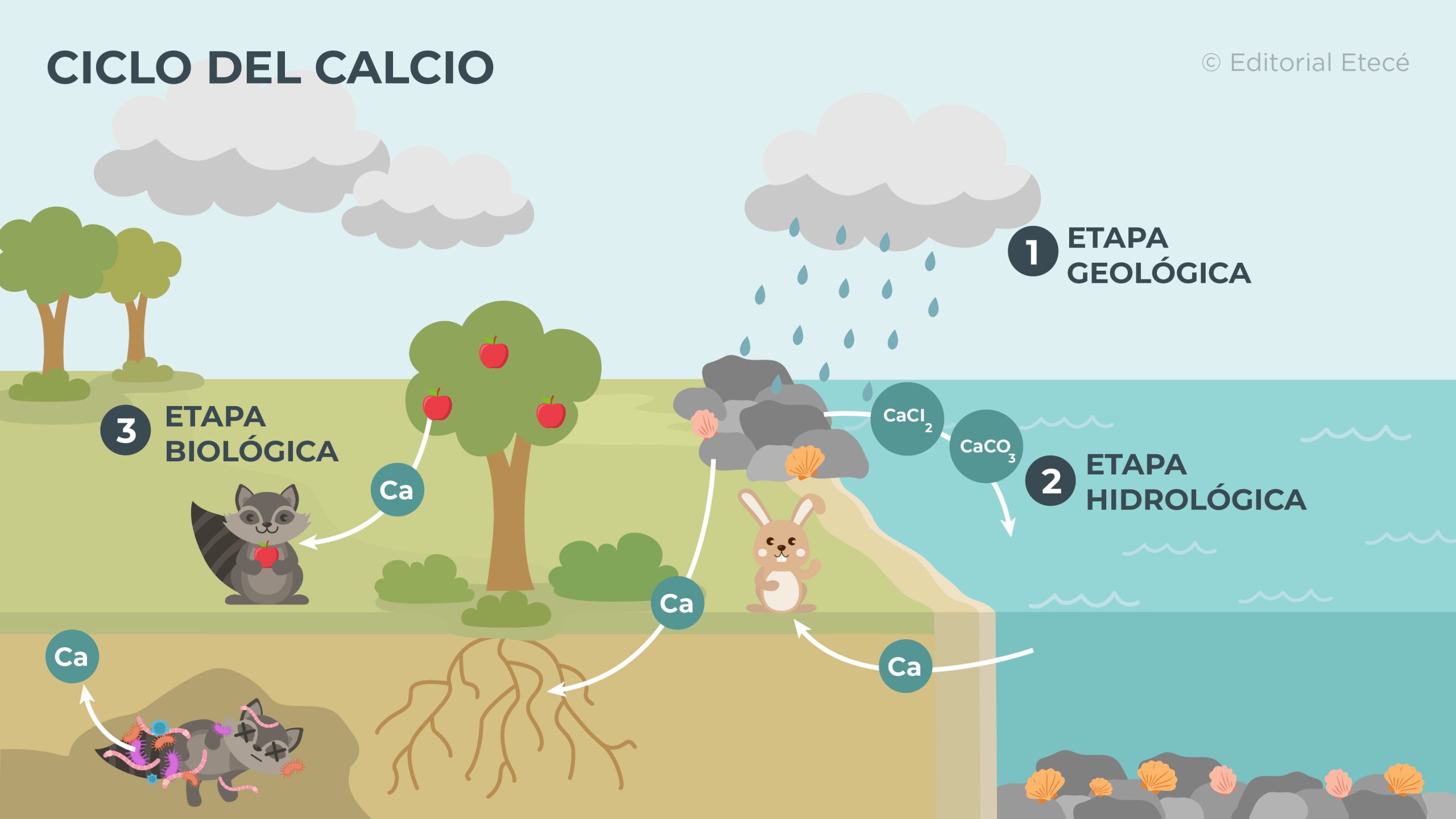
The calcium cycle is the process of calcium circulation on planet Earth. This cycle is of great importance, because Calcium makes up a large part of human bones and the structure of the shells of some animals.
The calcium cycle is made up of several stages.
- Geological stage Calcium is found accumulated on the earth's surface in large sediment deposits. These deposits emerged from the seabed and for this reason contain remains of the shells of marine animals rich in calcium. Some atmospheric agents, such as rain, degrade the rocks in these deposits and drag calcium into the soil.
- Hydrological stage Calcium is washed away by rain into rivers, seas and oceans in the form of calcium chloride (CaCl2) and calcium carbonate (CaCO3).
- Biological stage Plants take in calcium when they absorb water, while animals take it in when they eat plants or drink water. When both plants and animals die, calcium returns to the environment after the decomposition of these dead organisms.
Importance of biogeochemical cycles
Biogeochemical cycles are responsible for vital chemical elements circulating on the planet between living and non-living organisms, in this way, these elements can be recycled and reused over and over again by all ecosystems.
In this sense, these cycles guarantee that all living beings have access to the chemical elements necessary to sustain life For example, the calcium and potassium cycles guarantee that living beings can consume these elements that are essential for the correct functioning of their metabolism.
In addition, biogeochemical cycles contribute to regulating the climate on the planet, for example, the hydrological cycle regulates humidity levels in the atmosphere and influences temperatures.
Literature
- Esteve, P., & Jaén, M. (2013). “The role of biogeochemical cycles in the study of environmental problems in Secondary Education” Journal of Research in School, 80, 77-88.
- Gallardo, JF, Santa Regina, I., & Hernández, I. (1991). “Biogeochemical cycles in forest ecosystems: production versus decomposition” Biological Diversity. Ramón Areces Foundation269-271.
- Páez-Osuna, F. (2014). “Metals and metalloids: origin, mobility and biogeochemical cycles. Gulf of Mexico. Pollution and environmental impact: diagnosis and trends” UAC, UNAM-ICMyL, CINVESTAV-Unidad Mérida, 505-520.
- Maderey Rascón, L. Elena. (2005) “Principles of Hydrogeography. “Study of the Hydrological Cycle” National Autonomous University of Mexico. Institute of Geography. ISBN: 970-32-2812-7

